Jianfeng He
MDSEval: A Meta-Evaluation Benchmark for Multimodal Dialogue Summarization
Oct 02, 2025Abstract:Multimodal Dialogue Summarization (MDS) is a critical task with wide-ranging applications. To support the development of effective MDS models, robust automatic evaluation methods are essential for reducing both cost and human effort. However, such methods require a strong meta-evaluation benchmark grounded in human annotations. In this work, we introduce MDSEval, the first meta-evaluation benchmark for MDS, consisting image-sharing dialogues, corresponding summaries, and human judgments across eight well-defined quality aspects. To ensure data quality and richfulness, we propose a novel filtering framework leveraging Mutually Exclusive Key Information (MEKI) across modalities. Our work is the first to identify and formalize key evaluation dimensions specific to MDS. We benchmark state-of-the-art modal evaluation methods, revealing their limitations in distinguishing summaries from advanced MLLMs and their susceptibility to various bias.
ASPD: Unlocking Adaptive Serial-Parallel Decoding by Exploring Intrinsic Parallelism in LLMs
Aug 12, 2025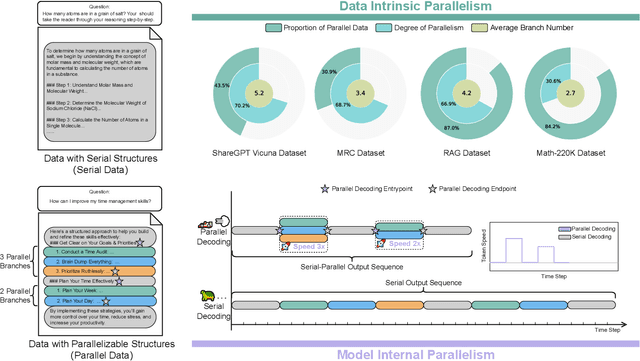
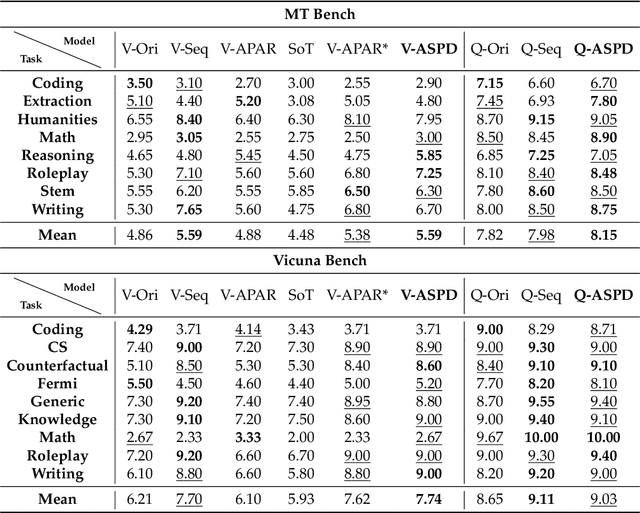
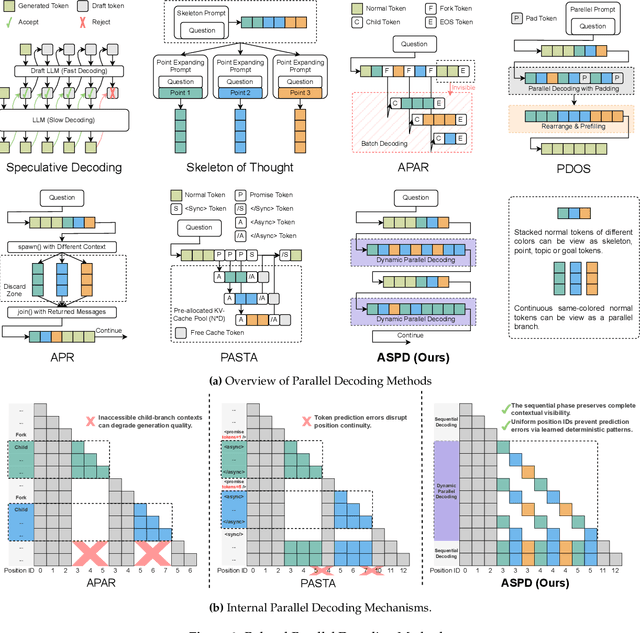

Abstract:The increasing scale and complexity of large language models (LLMs) pose significant inference latency challenges, primarily due to their autoregressive decoding paradigm characterized by the sequential nature of next-token prediction. By re-examining the outputs of autoregressive models, we observed that some segments exhibit parallelizable structures, which we term intrinsic parallelism. Decoding each parallelizable branch simultaneously (i.e. parallel decoding) can significantly improve the overall inference speed of LLMs. In this paper, we propose an Adaptive Serial-Parallel Decoding (ASPD), which addresses two core challenges: automated construction of parallelizable data and efficient parallel decoding mechanism. More specifically, we introduce a non-invasive pipeline that automatically extracts and validates parallelizable structures from the responses of autoregressive models. To empower efficient adaptive serial-parallel decoding, we implement a Hybrid Decoding Engine which enables seamless transitions between serial and parallel decoding modes while maintaining a reusable KV cache, maximizing computational efficiency. Extensive evaluations across General Tasks, Retrieval-Augmented Generation, Mathematical Reasoning, demonstrate that ASPD achieves unprecedented performance in both effectiveness and efficiency. Notably, on Vicuna Bench, our method achieves up to 3.19x speedup (1.85x on average) while maintaining response quality within 1% difference compared to autoregressive models, realizing significant acceleration without compromising generation quality. Our framework sets a groundbreaking benchmark for efficient LLM parallel inference, paving the way for its deployment in latency-sensitive applications such as AI-powered customer service bots and answer retrieval engines.
GLEAN: Generalized Category Discovery with Diverse and Quality-Enhanced LLM Feedback
Feb 25, 2025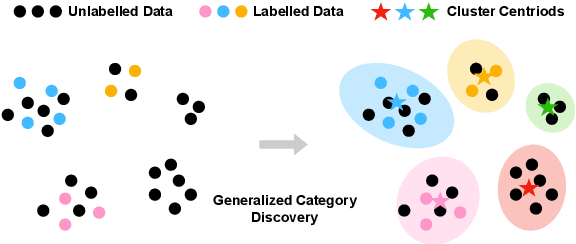
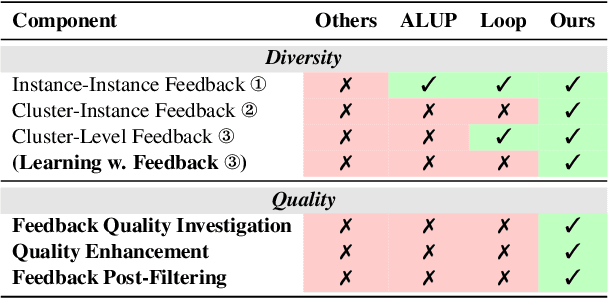
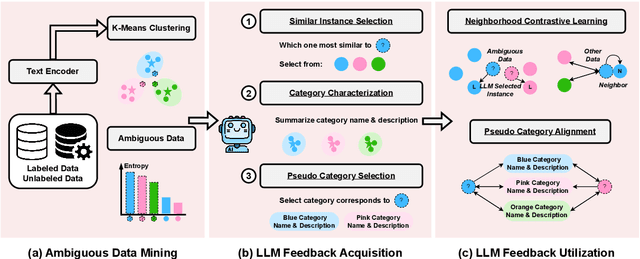
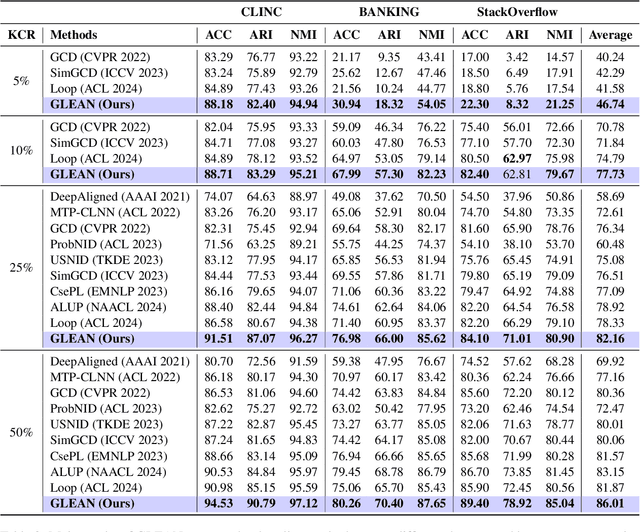
Abstract:Generalized Category Discovery (GCD) is a practical and challenging open-world task that aims to recognize both known and novel categories in unlabeled data using limited labeled data from known categories. Due to the lack of supervision, previous GCD methods face significant challenges, such as difficulty in rectifying errors for confusing instances, and inability to effectively uncover and leverage the semantic meanings of discovered clusters. Therefore, additional annotations are usually required for real-world applicability. However, human annotation is extremely costly and inefficient. To address these issues, we propose GLEAN, a unified framework for generalized category discovery that actively learns from diverse and quality-enhanced LLM feedback. Our approach leverages three different types of LLM feedback to: (1) improve instance-level contrastive features, (2) generate category descriptions, and (3) align uncertain instances with LLM-selected category descriptions. Extensive experiments demonstrate the superior performance of \MethodName over state-of-the-art models across diverse datasets, metrics, and supervision settings. Our code is available at https://github.com/amazon-science/Glean.
Faithful, Unfaithful or Ambiguous? Multi-Agent Debate with Initial Stance for Summary Evaluation
Feb 12, 2025Abstract:Faithfulness evaluators based on large language models (LLMs) are often fooled by the fluency of the text and struggle with identifying errors in the summaries. We propose an approach to summary faithfulness evaluation in which multiple LLM-based agents are assigned initial stances (regardless of what their belief might be) and forced to come up with a reason to justify the imposed belief, thus engaging in a multi-round debate to reach an agreement. The uniformly distributed initial assignments result in a greater diversity of stances leading to more meaningful debates and ultimately more errors identified. Furthermore, by analyzing the recent faithfulness evaluation datasets, we observe that naturally, it is not always the case for a summary to be either faithful to the source document or not. We therefore introduce a new dimension, ambiguity, and a detailed taxonomy to identify such special cases. Experiments demonstrate our approach can help identify ambiguities, and have even a stronger performance on non-ambiguous summaries.
Rethinking the Uncertainty: A Critical Review and Analysis in the Era of Large Language Models
Oct 26, 2024
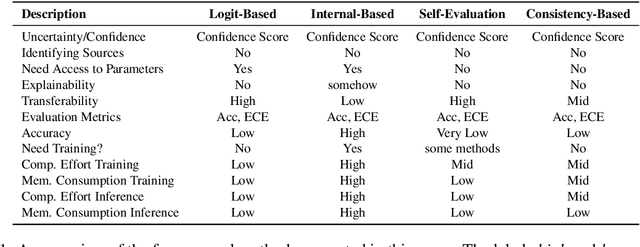
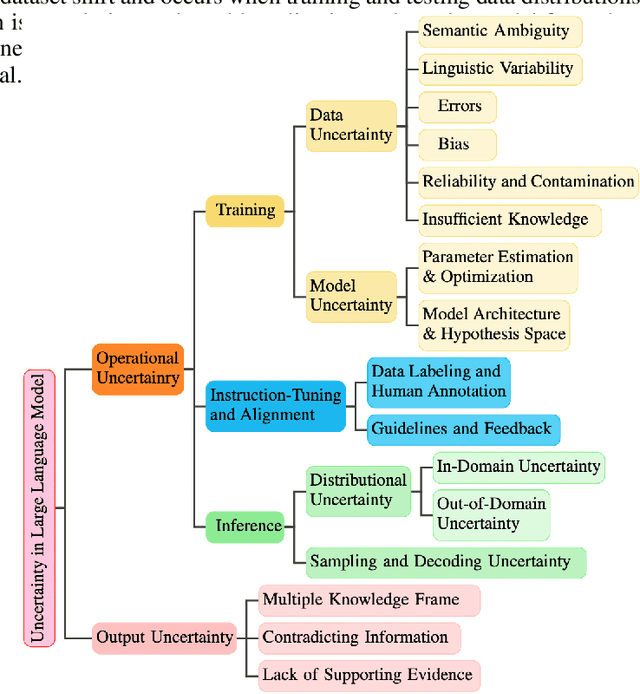
Abstract:In recent years, Large Language Models (LLMs) have become fundamental to a broad spectrum of artificial intelligence applications. As the use of LLMs expands, precisely estimating the uncertainty in their predictions has become crucial. Current methods often struggle to accurately identify, measure, and address the true uncertainty, with many focusing primarily on estimating model confidence. This discrepancy is largely due to an incomplete understanding of where, when, and how uncertainties are injected into models. This paper introduces a comprehensive framework specifically designed to identify and understand the types and sources of uncertainty, aligned with the unique characteristics of LLMs. Our framework enhances the understanding of the diverse landscape of uncertainties by systematically categorizing and defining each type, establishing a solid foundation for developing targeted methods that can precisely quantify these uncertainties. We also provide a detailed introduction to key related concepts and examine the limitations of current methods in mission-critical and safety-sensitive applications. The paper concludes with a perspective on future directions aimed at enhancing the reliability and practical adoption of these methods in real-world scenarios.
Large Language Models for Multimodal Deformable Image Registration
Aug 20, 2024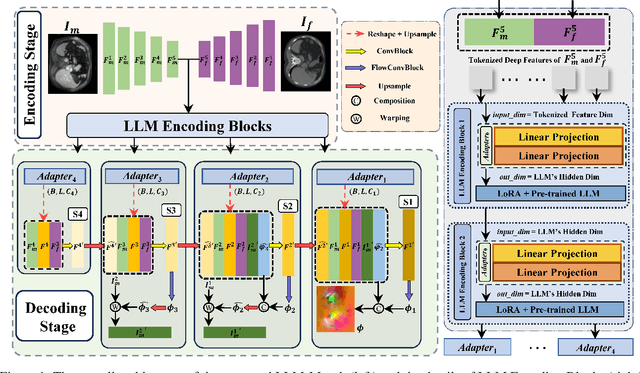
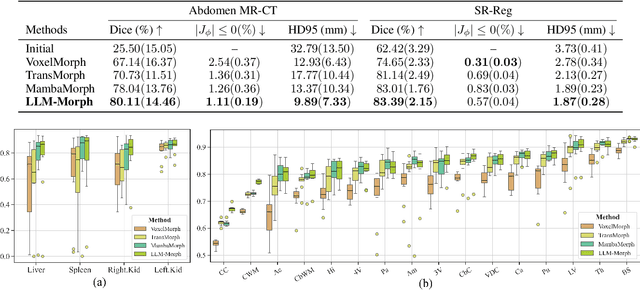
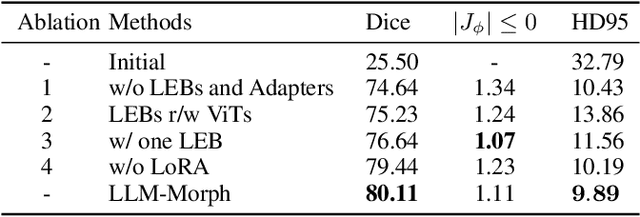
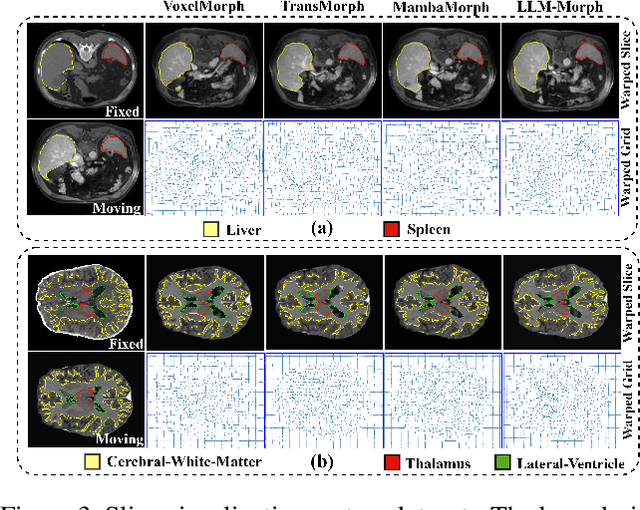
Abstract:The challenge of Multimodal Deformable Image Registration (MDIR) lies in the conversion and alignment of features between images of different modalities. Generative models (GMs) cannot retain the necessary information enough from the source modality to the target one, while non-GMs struggle to align features across these two modalities. In this paper, we propose a novel coarse-to-fine MDIR framework,LLM-Morph, which is applicable to various pre-trained Large Language Models (LLMs) to solve these concerns by aligning the deep features from different modal medical images. Specifically, we first utilize a CNN encoder to extract deep visual features from cross-modal image pairs, then we use the first adapter to adjust these tokens, and use LoRA in pre-trained LLMs to fine-tune their weights, both aimed at eliminating the domain gap between the pre-trained LLMs and the MDIR task. Third, for the alignment of tokens, we utilize other four adapters to transform the LLM-encoded tokens into multi-scale visual features, generating multi-scale deformation fields and facilitating the coarse-to-fine MDIR task. Extensive experiments in MR-CT Abdomen and SR-Reg Brain datasets demonstrate the effectiveness of our framework and the potential of pre-trained LLMs for MDIR task. Our code is availabel at: https://github.com/ninjannn/LLM-Morph.
CTP-LLM: Clinical Trial Phase Transition Prediction Using Large Language Models
Aug 20, 2024Abstract:New medical treatment development requires multiple phases of clinical trials. Despite the significant human and financial costs of bringing a drug to market, less than 20% of drugs in testing will make it from the first phase to final approval. Recent literature indicates that the design of the trial protocols significantly contributes to trial performance. We investigated Clinical Trial Outcome Prediction (CTOP) using trial design documents to predict phase transitions automatically. We propose CTP-LLM, the first Large Language Model (LLM) based model for CTOP. We also introduce the PhaseTransition (PT) Dataset; which labels trials based on their progression through the regulatory process and serves as a benchmark for CTOP evaluation. Our fine-tuned GPT-3.5-based model (CTP-LLM) predicts clinical trial phase transition by analyzing the trial's original protocol texts without requiring human-selected features. CTP-LLM achieves a 67% accuracy rate in predicting trial phase transitions across all phases and a 75% accuracy rate specifically in predicting the transition from Phase~III to final approval. Our experimental performance highlights the potential of LLM-powered applications in forecasting clinical trial outcomes and assessing trial design.
Can We Trust the Performance Evaluation of Uncertainty Estimation Methods in Text Summarization?
Jun 25, 2024Abstract:Text summarization, a key natural language generation (NLG) task, is vital in various domains. However, the high cost of inaccurate summaries in risk-critical applications, particularly those involving human-in-the-loop decision-making, raises concerns about the reliability of uncertainty estimation on text summarization (UE-TS) evaluation methods. This concern stems from the dependency of uncertainty model metrics on diverse and potentially conflicting NLG metrics. To address this issue, we introduce a comprehensive UE-TS benchmark incorporating 31 NLG metrics across four dimensions. The benchmark evaluates the uncertainty estimation capabilities of two large language models and one pre-trained language model on three datasets, with human-annotation analysis incorporated where applicable. We also assess the performance of 14 common uncertainty estimation methods within this benchmark. Our findings emphasize the importance of considering multiple uncorrelated NLG metrics and diverse uncertainty estimation methods to ensure reliable and efficient evaluation of UE-TS techniques.
InternalInspector $I^2$: Robust Confidence Estimation in LLMs through Internal States
Jun 17, 2024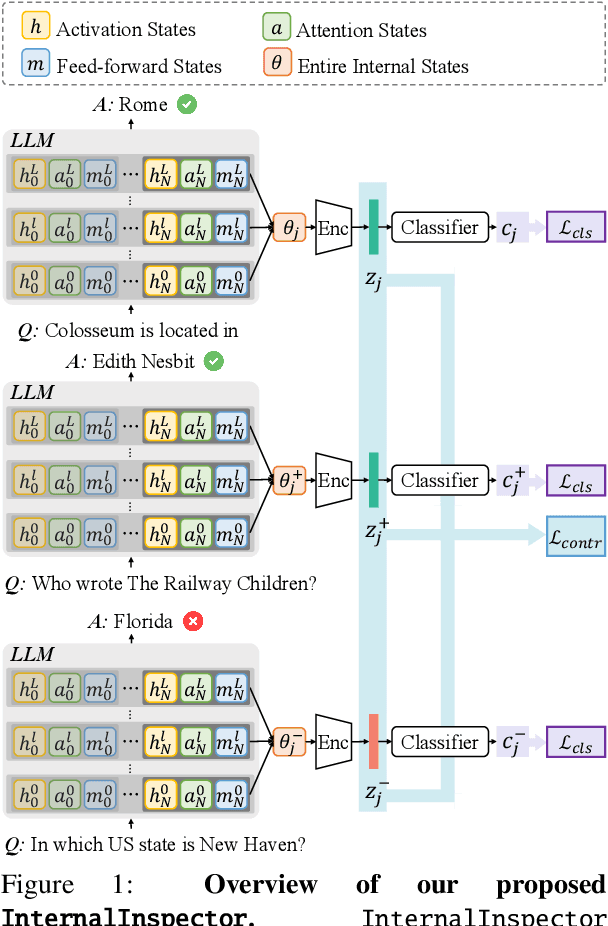
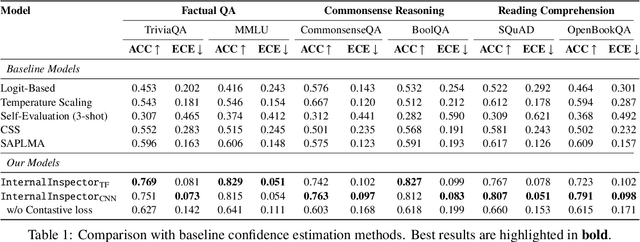
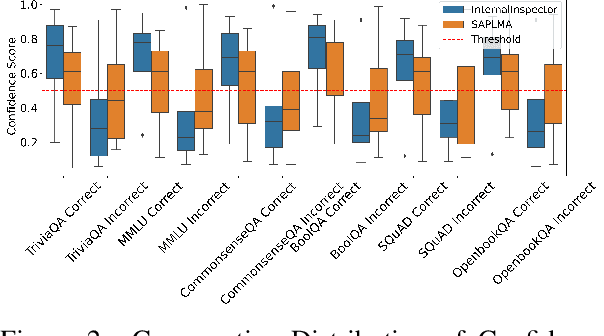
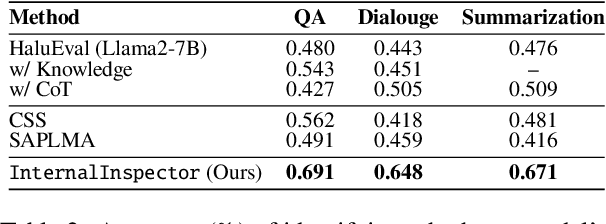
Abstract:Despite their vast capabilities, Large Language Models (LLMs) often struggle with generating reliable outputs, frequently producing high-confidence inaccuracies known as hallucinations. Addressing this challenge, our research introduces InternalInspector, a novel framework designed to enhance confidence estimation in LLMs by leveraging contrastive learning on internal states including attention states, feed-forward states, and activation states of all layers. Unlike existing methods that primarily focus on the final activation state, InternalInspector conducts a comprehensive analysis across all internal states of every layer to accurately identify both correct and incorrect prediction processes. By benchmarking InternalInspector against existing confidence estimation methods across various natural language understanding and generation tasks, including factual question answering, commonsense reasoning, and reading comprehension, InternalInspector achieves significantly higher accuracy in aligning the estimated confidence scores with the correctness of the LLM's predictions and lower calibration error. Furthermore, InternalInspector excels at HaluEval, a hallucination detection benchmark, outperforming other internal-based confidence estimation methods in this task.
Exploring the Deceptive Power of LLM-Generated Fake News: A Study of Real-World Detection Challenges
Apr 08, 2024Abstract:Recent advancements in Large Language Models (LLMs) have enabled the creation of fake news, particularly in complex fields like healthcare. Studies highlight the gap in the deceptive power of LLM-generated fake news with and without human assistance, yet the potential of prompting techniques has not been fully explored. Thus, this work aims to determine whether prompting strategies can effectively narrow this gap. Current LLM-based fake news attacks require human intervention for information gathering and often miss details and fail to maintain context consistency. Therefore, to better understand threat tactics, we propose a strong fake news attack method called conditional Variational-autoencoder-Like Prompt (VLPrompt). Unlike current methods, VLPrompt eliminates the need for additional data collection while maintaining contextual coherence and preserving the intricacies of the original text. To propel future research on detecting VLPrompt attacks, we created a new dataset named VLPrompt fake news (VLPFN) containing real and fake texts. Our experiments, including various detection methods and novel human study metrics, were conducted to assess their performance on our dataset, yielding numerous findings.
 Add to Chrome
Add to Chrome Add to Firefox
Add to Firefox Add to Edge
Add to Edge